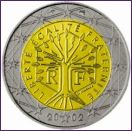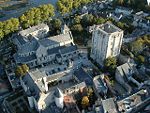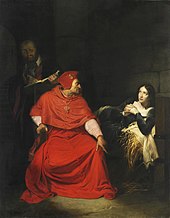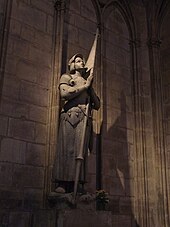| Saint Joan of Arc |
|---|

Painting, ca. 1485. An artist's interpretation, since the only known direct portrait has not survived. (Centre Historique des Archives Nationales, Paris, AE II 2490) |
| Saint |
|---|
| Born | ca. 6 January 1412
Domrémy, Duchy of Bar, Kingdom of France.[1] |
|---|
| Died | 30 May 1431 (aged approx. 19)
Rouen, France
(then controlled by England) |
|---|
| Honored in | Roman Catholic Church
Anglican Communion |
|---|
| Beatified | 18 April 1909, Notre Dame de Parisby Pope Pius X |
|---|
| Canonized | 16 May 1920, St. Peter's Basilica, Rome by Pope Benedict XV |
|---|
| Feast | 30 May |
|---|
| Patronage | France  ; martyrs; captives; military personnel; people ridiculed for their piety; prisoners; soldiers, women who have served in theWAVES (Women Appointed for Voluntary Emergency Service); and Women's Army Corps ; martyrs; captives; military personnel; people ridiculed for their piety; prisoners; soldiers, women who have served in theWAVES (Women Appointed for Voluntary Emergency Service); and Women's Army Corps |
|---|

Coat of Arms of Joan of Arc
Twenty-five years after her execution, an inquisitorial court authorized by Pope Callixtus IIIexamined the trial, pronounced her innocent, and declared her a martyr.[5] Joan of Arc wasbeatified in 1909 and canonized in 1920. She is – along with St. Denis, St. Martin of Tours,St. Louis IX, and St. Theresa of Lisieux – one of the patron saints of France. Joan said she had received visions from God instructing her to support Charles VII and recover France from English domination late in the Hundred Years' War. The uncrowned King Charles VII sent her to the siege of Orléans as part of a relief mission. She gained prominence when she overcame the dismissive attitude of veteran commanders and lifted the siege in only nine days. Several additional swift victories led to Charles VII's coronation at Reims.
To the present day, Joan of Arc has remained a significant figure in Western civilization. From Napoleon I onward, French politicians of all leanings have invoked her memory. Famous writers and composers who have created works about her include: William Shakespeare (Henry VI, Part 1), Voltaire (The Maid of Orleans), Friedrich Schiller (The Maid of Orleans), Giuseppe Verdi (Giovanna d'Arco), Pyotr Ilyich Tchaikovsky (The Maid of Orleans), Mark Twain (Personal Recollections of Joan of Arc), Arthur Honegger (Jeanne d'Arc au bûcher), Jean Anouilh (L'Alouette), Bertolt Brecht (Saint Joan of the Stockyards),George Bernard Shaw (Saint Joan), Maxwell Anderson (Joan of Lorraine), Leonard Cohen(Joan of Arc), and Orchestral Manoeuvres in the Dark (Joan of Arc). Cultural depictions of Joan of Arc have continued in film, theatre, television, video games, music, and performances.
Background
1412 —
–
1414 —
–
1416 —
–
1418 —
–
1420 —
–
1422 —
–
1424 —
–
1426 —
–
1428 —
–
1430 —
–
1432 —
c. 1412 – Approx. date of birth
c. 1424 – Described visions
8 May 1429 – Lifting of the siege of Orleans
30 May 1431 – Executed at Rouen, France
The historian Kelly DeVries describes the period preceding her appearance in the following terms: "If anything could have discouraged her, the state of France in 1429 should have." TheHundred Years' War had begun in 1337 as a succession dispute over the French thronewith intermittent periods of relative peace. Nearly all the fighting had taken place in France, and the English army's use of chevauchée tactics (similar to scorched earthstrategies) had devastated the economy.[6] The French population had not recovered from the Black Death of the previous century and its merchants were isolated from foreign markets. At the outset of Jeanne d'Arc's appearance, the English had nearly achieved their goal of a dual monarchy under English control and the French army had not achieved any major victories for a generation. In DeVries's words, "The kingdom of France was not even a shadow of its thirteenth-century prototype."[7]
The French king at the time of Joan's birth, Charles VI, suffered bouts of insanity[8] and was often unable to rule. The king's brother Duke Louis of Orléans and the king's cousinJohn the Fearless, Duke of Burgundy, quarreled over the regency of France and the guardianship of the royal children. This dispute escalated to accusations of an extramarital affair with Queen Isabeau of Bavaria and the kidnappings of the royal children.[citation needed]. The matter climaxed with the assassination of the Duke of Orléans in 1407 on the orders of the Duke of Burgundy.[9]
The factions loyal to these two men became known as the Armagnacs and the Burgundians. Henry V of England took advantage of this turmoil to invade France, winning a dramatic victory at Agincourt in 1415 and capturing many northern French towns.[10] The future French king, Charles VII, assumed the title of Dauphin – the heir to the throne – at the age of fourteen, after all four of his older brothers died in succession.[11] His first significant official act was to conclude a peace treaty with Burgundy in 1419. This ended in disaster when Armagnac partisans assassinated John the Fearless during a meeting under Charles's guarantee of protection. The new duke of Burgundy, Philip the Good, blamed Charles for the murder and entered into an alliance with the English. The allied forces conquered large sections of France.[12]
In 1420, Queen Isabeau of Bavaria concluded the Treaty of Troyes, which granted the succession of the French throne to Henry V and his heirs instead of her son Charles. This agreement revived rumors about her alleged affair with the late duke of Orléans and raised fresh suspicions that the Dauphin was illegitimate rather than the son of the king.[13] Henry V and Charles VI died within two months of each other in 1422, leaving an infant, Henry VI of England, the nominal monarch of both kingdoms. Henry V's brother, John of Lancaster, 1st Duke of Bedford, acted as regent.[14]
By the beginning of 1429, nearly all of northern France and some parts of the southwest were under foreign control. The English controlled Paris and Rouen while the Burgundians controlled Reims, the latter city being the traditional site of French coronations. This was an important consideration since neither claimant to the throne of France had yet been officially crowned. The English had laid siege to Orléans, one of the few remaining loyal French cities and a strategic position along the Loire River, which made it the last obstacle to an assault on the remainder of the French heartland. In the words of one modern historian, "On the fate of Orléans hung that of the entire kingdom."[15] No one was optimistic that the city could long withstand the siege.[16]
Life
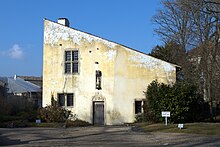
Joan's birthplace is now a museum. The village church where she attended Mass is on the right behind the trees.
Joan was born the daughter of Jacques d'Arc and Isabelle Romée.[17] in Domrémy, a village which was then in the French part of the duchy of Bar, or Barrois mouvant, situated West of the Meuse River, while the rest of the duchy (East of the Meuse) was a part of the Holy Roman Empire. The duchy of Bar was later incorporated to the province of Lorraine and the village of Domrémy renamed Domrémy-la-Pucelle, in honor of Joan of Arc.[18] Joan's parents owned about 50 acres (20 hectares) of land and her father supplemented his farming work with a minor position as a village official, collecting taxes and heading the local watch.[19]They lived in an isolated patch of eastern France that remained loyal to the French crown despite being surrounded by Burgundian lands. Several local raids occurred during her childhood and on one occasion her village was burned.
Joan said she was about 19 at her trial, so she must have been born around the year 1412. She later testified that she experienced her first vision around 1424 at the age of 12 years, when she was out alone in a field and saw visions of figures she identified as Saint Michael, Saint Catherine, and Saint Margaret, who told her to drive out the English and bring the Dauphin to Reims for his coronation. She said she cried when they left, as they were so beautiful.[20]
At the age of 16, she asked a kinsman, Durand Lassois, to bring her to nearby Vaucouleurs, where she petitioned the garrison commander, Count Robert de Baudricourt, for permission to visit the royal French court at Chinon. Baudricourt's sarcastic response did not deter her.[21] She returned the following January and gained support from two men of standing: Jean de Metz and Bertrand de Poulengy.[22] Under their auspices, she gained a second meeting, where she made a remarkable prediction about a military reversalnear Orléans.[23]
Rise

1415-1429
Main battles
English raid of 1415 Joan's journey from Domrémy to Chinon Raid of Jeanne d'Arc to Reims in 1429
Robert de Baudricourt granted her an escort to visit Chinon after news from the front confirmed her prediction. She made the journey through hostile Burgundian territory in male disguise.[24] Upon arriving at the Royal Court she impressed Charles VII during a private conference. During this time Charles's mother-in-law Yolande of Aragon was financing a relief expedition to Orléans. Joan asked for permission to travel with the army and wear the equipment of a knight. She depended on donated items for her armor, horse, sword, banner, and other items utilized by her entourage. Historian Stephen W. Richey explains her attraction to the Royal Court by pointing out that they may have viewed her as the only source of hope for a regime that was near collapse:
| After years of one humiliating defeat after another, both the military and civil leadership of France were demoralized and discredited. When the Dauphin Charles granted Joan’s urgent request to be equipped for war and placed at the head of his army, his decision must have been based in large part on the knowledge that every orthodox, every rational option had been tried and had failed. Only a regime in the final straits of desperation would pay any heed to an illiterate farm girl who claimed that the voice of God was instructing her to take charge of her country’s army and lead it to victory. |
Upon her arrival, Joan effectively turned the longstanding Anglo-French conflict into a religious war.[25] But this course of action was not without its risks. Charles' advisers were worried that unless Joan's orthodoxy could be established beyond doubt – that she was not a heretic or a sorceress – Charles' enemies could easily make the claim that his kingdom was a gift from the Devil. To circumvent this possibility, the Dauphin ordered background inquiries and a theological examination at Poitiers to verify her morality. In April 1429, the commission of inquiry "declared her to be of irreproachable life, a good Christian, possessed of the virtues of humility, honesty and simplicity."[25] The theologians at Poitiers did not pass judgment on her divine inspiration; rather, they informed the Dauphin that there was a 'favorable presumption' to be made on the divine nature of her mission. This was enough for Charles, but they put the ball back in his court by stating that he had an obligation to put Joan to the test. 'To doubt or abandon her without suspicion of evil would be to repudiate the Holy Spirit and to become unworthy of God's aid', they declared.[26] The test for the truth of her claims would be the raising of the siege of Orléans.
She arrived at the siege of Orléans on 29 April 1429, but Jean d'Orléans, the acting head of the Orléans ducal family, initially excluded her from war councils and failed to inform her when the army engaged the enemy.[27] However, his exclusions did not prevent her presence at most councils and battles.
The extent of her actual military leadership is a subject of historical debate. Traditional historians, such as Édouard Perroy, conclude that she was a standard bearer whose primary effect was on morale.[28] This type of analysis usually relies on the condemnation trial testimony, where she stated that she preferred her standard to her sword. Recent scholarship that focuses on the nullification trial testimony asserts that the army's commanders esteemed her as a skilled tactician and a successful strategist. Stephen W. Richey's opinion is one example: "She proceeded to lead the army in an astounding series of victories that reversed the tide of the war."[24] In either case, historians agree that the army enjoyed remarkable success during her brief career.[29]
Leadership
| "... the Maiden lets you know that here, in eight days, she has chased the English out of all the places they held on the river Loire by attack or other means: they are dead or prisoners or discouraged in battle. Believe what you have heard about the earl of Suffolk, the lord la Pole and his brother, the lord Talbot, the lord Scales, and Sir Fastolf; many more knights and captains than these are defeated." |
| Her Letter to the citizens of Tournai, 25 June 1429; Quicherat V, pp. 125–126, trans. Wikipedia. |
Joan of Arc rejected the cautious strategy that characterized French leadership during previous campaigns. During the five months of siege before her arrival, the defenders of Orléans attempted only one aggressive move and that ended in disaster. On 4 May the French attacked and captured the outlying fortress of Saint Loup, which she followed on 5 May with a march to a second fortress called Saint Jean le Blanc, which was found deserted. The next day she opposed Jean d'Orleans at a war council where she demanded another assault on the enemy. D'Orleans ordered the city gates locked to prevent another battle, but she summoned the townsmen and common soldiers and forced the mayor to unlock a gate. With the aid of only one captain she rode out and captured the fortress of Saint Augustins. That evening she learned she had been excluded from a war council where the leaders had decided to wait for reinforcements before acting again. Disregarding this decision, she insisted on attacking the main English stronghold called "les Tourelles" on 7 May.[30]Contemporaries acknowledged her as the heroine of the engagement after she was wounded in the neck by an arrow but returned to lead the final charge.[31]
The sudden victory at Orléans led to many proposals for further offensive action. The English expected an attempt to recapture Paris or an attack on Normandy. In the aftermath of the unexpected victory, Joan persuaded Charles VII to grant her co-command of the army with Duke John II of Alençon and gained royal permission for her plan to recapture nearby bridges along the Loire as a prelude to an advance on Reims and the coronation of Charles VII. This was a bold proposal because Reims was roughly twice as far away as Paris and deep within enemy territory.[32]
The army recovered Jargeau on 12 June, Meung-sur-Loire on 15 June, and Beaugency on 17 June. The Duke of Alençon agreed to all of Joan's decisions. Other commanders including Jean d'Orléans had been impressed with her performance at Orléans and became her supporters. Alençon credited her with saving his life at Jargeau, where she warned him of an imminent artillery attack.[33] During the same battle she withstood a blow from a stone cannonball to her helmet as she climbed a scaling ladder. An expected English relief force arrived in the area on 18 June under the command of Sir John Fastolf. The battle at Patay might be compared to Agincourt in reverse. The French vanguard attacked before the English archers could finish defensive preparations. A rout ensued that decimated the main body of the English army and killed or captured most of its commanders. Fastolf escaped with a small band of soldiers and became the scapegoat for the humiliating English defeat. The French suffered minimal losses.[34]
| "Prince of Burgundy, I pray of you — I beg and humbly supplicate — that you make no more war with the holy kingdom of France. Withdraw your people swiftly from certain places and fortresses of this holy kingdom, and on behalf of the gentle king of France I say he is ready to make peace with you, by his honor." |
| "Her Letter to Philip the Good, Duke of Burgundy, 17 July 1429; Quicherat V, pp. 126–127, trans. Wikipedia. |
The French army set out for Reims from Gien-sur-Loire on 29 June and accepted the conditional surrender of the Burgundian-held city of Auxerreon 3 July. The other towns in their path returned to French allegiance without resistance. Troyes, the site of the treaty that tried to disinherit Charles VII, capitulated after a bloodless four-day siege.[35] The army was in short supply of food by the time it reached Troyes. But the army was in luck: a wandering friar named Brother Richard had been preaching about the end of the world at Troyes and convinced local residents to plant beans, a crop with an early harvest. The hungry army arrived as the beans ripened.[36]
Reims opened its gates to the army on 16 July. The coronation took place the following morning. Although Joan and the duke of Alençon urged a prompt march on Paris, the royal court preferred a negotiated truce with the duke of Burgundy. Duke Philip the Good broke the agreement, using it as a stalling tactic to reinforce the defense of Paris.[37] The French army marched through towns near Paris during the interim and accepted more peaceful surrenders. The Duke of Bedford headed an English force and confronted the French army in a standoff on 15 August. The French assault at Paris ensued on 8 September. Despite a wound to the leg from a crossbow bolt, Joan continued directing the troops until the day's fighting ended. The following morning she received a royal order to withdraw. Most historians blame French Grand Chamberlain Georges de la Trémoille for the political blunders that followed the coronation.[38] In October, Joan was with the Royal army when it took Saint-Pierre-le-Moûtier, followed by an unsuccessful attempt to take La-Charité-sur-Loire in November and December. On 29 December, Joan and her family were granted nobility.
Ruin of the great hall at
Château de Chinon where she met the future King Charles VII. The castle's only remaining intact tower has also become a museum dedicated to her.
Entrance of Joan of Arc into Reims in 1429, painting by
Jan Matejko
The inner keep at
Beaugency is one of the few surviving fortifications from Joan's battles. English defenders retreated to the tower at upper right after the French breached the town wall.
Notre-Dame de Reims, traditional site of French coronations. The structure had additional spires prior to a 1481 fire.
Joan at the coronation of Charles VII, by
Jean Auguste Dominique Ingres in 1854, is a notable example of attempts to add more feminine characteristics to her appearance. Note the long hair and the skirt around the armor.
Capture

Joan captured by the Burgundians at Compiègne. Mural in the Panthéon, Paris.
A truce with England during the following few months left Joan with little to do. On 23 March 1430, she dictated a threatening letter to the Hussites, a dissident group which had broken with the Catholic Church on a number of doctrinal points and had defeated several previous crusades sent against them. Joan's letter promises to "remove your madness and foul superstition, taking away either your heresy or your lives."[39] However, the truce with England quickly came to an end. Joan traveled to Compiègne the following May to help defend the city against an English and Burgundian siege. A skirmish on 23 May 1430 led to her capture, when her force attempted to attack the Burgundian's camp at Margny.[40] When she ordered a retreat into the nearby fortifications of Compiègne after the advance of an additional force of 6,000 Burgundians,[40] she assumed the place of honor as the last to leave the field. Burgundians surrounded the rear guard, and she was unhorsed by an archerand initially refused to surrender.[41]
| "It is true that the king has made a truce with the duke of Burgundy for fifteen days and that the duke is to turn over the city of Paris at the end of fifteen days. Yet you should not marvel if I do not enter that city so quickly. I am not content with these truces and do not know if I will keep them, but if I hold them it will only be to guard the king's honor: no matter how much they abuse the royal blood, I will keep and maintain the royal army in case they make no peace at the end of those fifteen days." |
| Her Letter to the citizens of Reims, 5 August 1429; Quicherat I, p. 246, trans. Wikipedia. |
It was customary for a captive's family to ransom a prisoner of war. Joan was in an unusual circumstance. Many historians condemn King Charles VII for failing to intervene. She attempted several escapes, on one occasion jumping from her 70 foot (21 m) tower in Vermandois to the soft earth of a dry moat, after which she was moved to the Burgundian town of Arras.[42] The English government eventually purchased her from Duke Philip of Burgundy. BishopPierre Cauchon of Beauvais, an English partisan, assumed a prominent role in these negotiations and her later trial.[43]
Trial

The keep of the castle of Rouen, surviving remnant of the fortress where Joan was imprisoned during her trial. It has since become known as the Joan of Arc tower.
The trial for heresy was politically motivated. The Duke of Bedford claimed the throne of France on behalf of his nephew Henry VI. Joan had been responsible for the rival coronation, hence condemning her was an attempt to undermine her king's legitimacy. Legal proceedings commenced on 9 January 1431 at Rouen, the seat of the English occupation government.[44] The procedure was irregular on a number of points.
To summarize some major problems: Under ecclesiastical law, Bishop Cauchon lacked jurisdiction over the case.[45] He owed his appointment to his partisan support of the English government which financed the trial. Clerical notary Nicolas Bailly, commissioned to collect testimony against Joan, could find no adverse evidence.[46] Without such evidence the court lacked grounds to initiate a trial. Opening a trial anyway, the court also violated ecclesiastical law in denying her right to a legal adviser. Upon the opening of the first public examination Joan complained that those present were all partisans against her and asked for "ecclesiastics of the French side" to be invited.[47]
The trial record demonstrates her remarkable intellect. The transcript's most famous exchange is an exercise in subtlety. "Asked if she knew she was in God's grace, she answered: 'If I am not, may God put me there; and if I am, may God so keep me.'"[48] The question is a scholarly trap. Church doctrine held that no one could be certain of being in God's grace. If she had answered yes, then she would have convicted herself of heresy. If she had answered no, then she would have confessed her own guilt. Notary Boisguillaume later testified that at the moment the court heard this reply, "Those who were interrogating her were stupefied."[49] In the twentieth century George Bernard Shaw found this dialogue so compelling that sections of his play Saint Joan are literal translations of the trial record.[50]
Several court functionaries later testified that significant portions of the transcript were altered in her disfavor. Many clerics served under compulsion, including the inquisitor, Jean LeMaitre, and a few even received death threats from the English. Under Inquisitorialguidelines, Joan should have been confined to an ecclesiastical prison under the supervision of female guards (i.e., nuns). Instead, the English kept her in a secular prison guarded by their own soldiers. Bishop Cauchon denied Joan's appeals to the Council of Basel and the pope, which should have stopped his proceeding.[51]
The twelve articles of accusation that summarize the court's finding contradict the already doctored court record.[52] The illiterate defendant signed an abjuration document she did not understand under threat of immediate execution. The court substituted a different abjuration in the official record.[53]
Execution
Heresy was a capital crime only for a repeat offense. Joan agreed to wear feminine clothing when she abjured. A few days later she told a tribunal member that "a great English lord had entered her prison and tried to take her by force."[56] She resumed male attire either as a defense against molestation or, in the testimony of Jean Massieu, because her dress had been stolen and she was left with nothing else to wear.[57] In terms of doctrine, she had been safe to disguise herself as a page during her journey through enemy territory and she was safe to wear armor during battle. The Chronique de la Pucelle states that it deterred molestation while she was camped in the field. Clergy who later testified at the posthumous rehabilitation trial affirmed that she continued to wear male clothing in prison to deter molestation and rape.[58] Preservation of chastity was another justifiable reason for cross-dressing: her apparel would have slowed an assailant, and men would be less likely to think of her as an object of desire in any case.[59]
She referred the court to the Poitiers inquiry when questioned on the matter. The Poitiers record no longer survives but circumstances indicate the Poitiers clerics had approved her practice. In other words, she had a mission to do a man's work so it was fitting that she dress the part.[60] She also kept her hair cut short through her military campaigns and while in prison. Her supporters, such as the theologian Jean Gerson, defended her hairstyle, as did Inquisitor Brehal later during the Rehabilitation trial.[61] Nonetheless, at the trial in 1431 she was condemned and sentenced to die.
Eyewitnesses described the scene of the execution by burning on 30 May 1431. Tied to a tall pillar at the Vieux-Marché in Rouen, she asked two of the clergy, Fr Martin Ladvenu and Fr Isambart de la Pierre, to hold a crucifix before her. A peasant also constructed a small cross which she put in the front of her dress. After she died, the English raked back the coals to expose her charred body so that no one could claim she had escaped alive, then burned the body twice more to reduce it to ashes and prevent any collection of relics. They cast her remains into the Seine from the only bridge called Mathilda.[62] The executioner, Geoffroy Therage, later stated that he "...greatly feared to be damned."[63]
Posthumous events
The Hundred Years' War continued for twenty-two years after her death. Charles VII succeeded in retaining legitimacy as the king of France in spite of a rival coronation held for Henry VI in December 1431 on the boy's tenth birthday. Before England could rebuild its military leadership and force of longbowmen, lost in 1429, the country lost its alliance with Burgundy at the Treaty of Arras in 1435. The Duke of Bedford died the same year and Henry VI became the youngest king of England to rule without a regent; his weak leadership was probably the most important factor in ending the conflict. Kelly DeVries argues that Joan of Arc's aggressive use of artillery and frontal assaults influenced French tactics for the rest of the war.[64]
In 1452, during the posthumous investigation into her execution, the Church declared that a religious play in her honor at Orléans would allow attendees to gain an indulgence (remission of temporal punishment for sin) by making a pilgrimage to the event.
Retrial
A posthumous retrial opened after the war ended. Pope Callixtus III authorized this proceeding, also known as the "nullification trial", at the request of Inquisitor-General Jean Brehal and Joan's mother Isabelle Romée. The aim of the trial was to investigate whether the trial of condemnation and its verdict had been handled justly and according to canon law. Investigations started with an inquest by a priest, Guillaume Bouille. Brehal conducted an investigation in 1452. A formal appeal followed in November 1455. The appellate process involved clergy from throughout Europe and observed standard court procedure. A panel of theologians analyzed testimony from 115 witnesses. Brehal drew up his final summary in June 1456, which describes Joan as a martyr and implicated the late Pierre Cauchon with heresy for having convicted an innocent woman in pursuit of asecular vendetta. The technical reason for her execution had been a Biblical clothing law.[65] The nullification trial reversed the conviction in part because the condemnation proceeding had failed to consider the doctrinal exceptions to that stricture. The appellate court declared her innocent on 7 July 1456.[66]
Canonization
She became a symbol of the Catholic League during the 16th century. When Félix Dupanloup was made bishop of Orléans in 1849, he pronounced a fervid panegyric on Joan of Arc, which attracted attention in England as well as France and he led the efforts which culminated in Joan of Arc's beatification in 1909. Pope Benedict XV canonized Joan on 16 May 1920. As Saint Joan of Arc, she has become one of the most popular saints of the Roman Catholic Church.[67]
Legacy

Joan of Arc dictated her letters. Three of the surviving ones are signed Jehanne.
Joan of Arc became a semi-legendary figure for the four centuries after her death. The main sources of information about her were chronicles. Five original manuscripts of her condemnation trial surfaced in old archives during the 19th century. Soon historians also located the complete records of her rehabilitation trial, which contained sworn testimony from 115 witnesses, and the original French notes for the Latin condemnation trial transcript. Various contemporary letters also emerged, three of which carry the signature Jehanne in the unsteady hand of a person learning to write.[68] This unusual wealth of primary source material is one reason DeVries declares, "No person of the Middle Ages, male or female, has been the subject of more study."[69]
Joan of Arc came from an obscure village and rose to prominence when she was a teenager, and she did so as an uneducated peasant. The French and English kings had justified the ongoing war through competing interpretations of the thousand-year-old Salic law. The conflict had been an inheritance feud between monarchs. She gave meaning to appeals such as that of squire Jean de Metz when he asked, "Must the king be driven from the kingdom; and are we to be English?"[22] In the words of Stephen Richey, "She turned what had been a dry dynastic squabble that left the common people unmoved except for their own suffering into a passionately popular war of national liberation."[24] Richey also expresses the breadth of her subsequent appeal:
The people who came after her in the five centuries since her death tried to make everything of her: demonic fanatic, spiritual mystic, naive and tragically ill-used tool of the powerful, creator and icon of modern popular nationalism, adored heroine, saint. She insisted, even when threatened with torture and faced with death by fire, that she was guided by voices from God. Voices or no voices, her achievements leave anyone who knows her story shaking his head in amazed wonder.
Joan of Arc was not a feminist. She operated within a religious tradition that believed an exceptional person from any level of society might receive a divine calling. She expelled women from the French army and may have struck one stubborn camp follower with the flat of a sword.[70][71] Nonetheless, some of her most significant aid came from women. King Charles VII's mother-in-law, Yolande of Aragon, confirmed Joan's virginity and financed her departure to Orléans. Joan of Luxembourg, aunt to the count of Luxembourg who held custody of her after Compiègne, alleviated her conditions of captivity and may have delayed her sale to the English. Finally, Anne of Burgundy, the duchess of Bedford and wife to the regent of England, declared Joan a virgin during pretrial inquiries.[72] For technical reasons this prevented the court from charging her with witchcraft. Ultimately this provided part of the basis for her vindication and sainthood. From Christine de Pizan to the present, women have looked to her as a positive example of a brave and active female.[73]
Joan of Arc has been a political symbol in France since the time of Napoleon. Liberals emphasised her humble origins. Earlyconservatives stressed her support of the monarchy. Later conservatives recalled her nationalism. During World War II, both the Vichy Regime and the French Resistance used her image: Vichy propaganda remembered her campaign against the English with posters that showed British warplanes bombing Rouen and the ominous caption: "They Always Return to the Scene of Their Crimes." The resistance emphasised her fight against foreign occupation and her origins in the province of Lorraine, which had fallen under Nazi control.
Three separate vessels of the French Navy have been named after her, including a helicopter carrier which was retired from active service on 7 June 2010. At present the controversial French far-right political party Front National holds rallies at her statues, reproduces her likeness in party publications, and uses a tricolor flame partly symbolic of her martyrdom as its emblem. This party's opponents sometimes satirize its appropriation of her image.[74] The French civic holiday in her honour is the second Sunday of May.
Philippe-Alexandre Le Brun de Charmettes is the first historian who wrote Joan of Arc's complete history[75] in 1817, in an attempt to restore her family's reputation from Joan's status as a relapsed heretic. His interest in Joan came at a time when France was still struggling to define its new identity after the Revolution and the Napoleonic wars. The national ethos was in search of non-controversial heroes. As a staunch supporter of King and country, Joan of Arc was an acceptable symbol to the monarchists. As a patriot and the daughter of commoners, she was seen as one prototype of the low-born volunteers (the soldats de l'an II) who had victoriously fought for revolutionary France in 1802 and as such could be claimed by the Republicans. As a religious martyr, she was also popular in the powerful Catholic community. De Charmette's Orléanide, today largely forgotten, was another attempt to magnify the national ethos as writers like Virgil (the Aeneid), or Camoens (Os Lusíadas) had done for Rome and Portugal.
Visions

Jeanne d' Arc, by Eugene Thirion (1876). Late 19th century images such as this often had political undertones because of French territorial cessions to Germany in 1871. (Chautou, Church of Notre Dame)
Joan of Arc's religious visions have remained an ongoing topic of interest. The consensus among scholars is that her faith was sincere. She identified Saint Margaret, Saint Catherine, and Saint Michael as the source of her revelations, although there is some ambiguity as to which of several identically named saints she intended. Some Catholics regard her visions as divine inspiration.
Analysis of her visions is problematic since the main source of information on this topic is the condemnation trial transcript in which she defied customary courtroom procedure about a witness' oath and specifically refused to answer every question about her visions. She complained that a standard witness oath would conflict with an oath she had previously sworn to maintain confidentiality about meetings with her king. It remains unknown to what extent the surviving record may represent the fabrications of corrupt court officials or her own possible fabrications to protect state secrets.[76] Some historians sidestep speculation about the visions by asserting that her belief in her calling is more relevant than questions about the visions' ultimate origin.[77]
Documents from her own era and historians prior to the 20th century generally assume that she was both healthy and sane.
A number of more recent scholars attempted to explain her visions in psychiatric or neurological terms. Potential diagnoses have included epilepsy, migraine, tuberculosis, andschizophrenia.[78] None of the putative diagnoses have gained consensus support, possibly due to the limited amount of information available about Joan's life. Two experts who analyse a temporal lobe tuberculoma hypothesis in the medical journal Neuropsychobiology express their misgivings this way:
It is difficult to draw final conclusions, but it would seem unlikely that widespread tuberculosis, a serious disease, was present in this "patient" whose life-style and activities would surely have been impossible had such a serious disease been present.[79]
In response to another such theory alleging that she suffered from bovine tuberculosis as a result of drinking unpasteurized milk, historian Régine Pernoud wrote that if drinking unpasteurized milk could produce such potential benefits for the nation, then the French government should stop mandating the pasteurization of milk.[80]
The fact that Joan of Arc gained favor in the court of King Charles VII has been suggested as evidence against mental illness hypotheses. The argument suggests that Charles VII would have been able to recognize "madness" because his own father, Charles VI, suffered from it. Charles VI was popularly known as "Charles the Mad", and much of the political and military decline that France had suffered during his reign could be attributed to the power vacuum that his episodes of insanity had produced. The previous king had believed he was made of glass, a delusion no courtier had mistaken for a religious awakening. Fears that King Charles VII would manifest the same insanity may have factored into the attempt to disinherit him at Troyes. This stigma was so persistent that contemporaries of the next generation would attribute to inherited madness the breakdown that England's King Henry VI was to suffer in 1453: Henry VI was nephew to Charles VII and grandson to Charles VI. Upon Joan's arrival at Chinon the royal counselor Jacques Gélu cautioned,
One should not lightly alter any policy because of conversation with a girl, a peasant ... so susceptible to illusions; one should not make oneself ridiculous in the sight of foreign nations.
The court of Charles VII was shrewd and skeptical on the subject of mental health.[81][82]
Also potentially relevant is the fact that she displayed none of the objective symptoms that can accompany the mental illnesses which have been suggested, such as schizophrenia. She remained astute to the end of her life and the rehabilitation trial testimony frequently marvels at her astuteness:
Often they [the judges] turned from one question to another, changing about, but, notwithstanding this, she answered prudently, and evinced a wonderful memory.[83]
Her subtle replies under interrogation even forced the court to stop holding public sessions.[49]
Although mental illness does not necessarily include severe cognitive impairment, nonetheless the various psychiatric conditions which have been specifically suggested to explain Joan's experiences would include certain detrimental symptoms which are among the diagnostic criteria. For example, in the case of schizophrenia the American Psychiatric Association's Diagnostic and Statistical Manual of Mental Disorders lists detrimental and noticeable side effects such as disorganized speech, disorganized or catatonic behavior, affective flattening, alogia, and avolition, among other effects.[84] As noted farther above, these symptoms do not appear to have been present in Joan's case.
Some psychiatrists have also urged that a distinction should be made between different types of experiences. Ralph Hoffman, professor of psychology at Yale University, argues that visionary and creative states, including "hearing voices", are not necessarily signs of mental illness. He lists Joan of Arc's case as a possible example of what Hoffman describes as an "inspired voice", without elaborating on the term.[85]
Alleged relics disproven
In 1867, a jar was found in a Paris pharmacy with the inscription "Remains found under the stake of Joan of Arc, virgin of Orleans". They consisted of a charred human rib, carbonized wood, a piece of linen and a cat femur – explained as the practice of throwing black cats onto the pyre of witches. They are now in the Museum of Art and History in Chinon museum. In 2006, Philippe Charlier, a forensic scientist at Raymond Poincaré Hospital (Garches) was authorized to study the relics. Carbon-14 tests and various spectroscopic analyses were performed, and the results[86] show that the remains come from an Egyptian mummy from the sixth to the third century BC. The charred appearance comes from the embalming substances, not from combustion. Large amounts of pine pollen were also found, consistent with the presence of resin used in mummification and some unburned linen was found to be similar to that used to wrap mummies. The famous perfumers Guerlain and Jean Patou said that they could smell vanilla in the remains, also consistent with mummification. Apparently the mummy was part of the ingredients of medieval pharmacopoeia and it was relabeled in a time of French nationalism.


